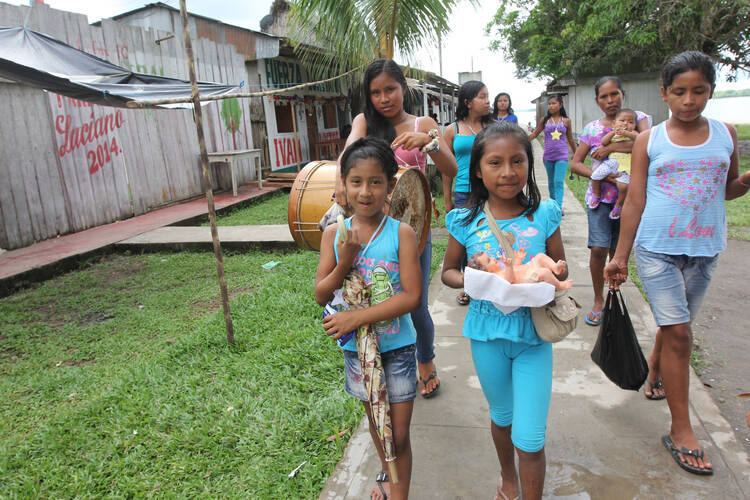SANTA RITA DE CASTILLA, Peru (CNS) -- It took all morning to build Bethlehem on Christmas Eve.
To the right of the altar in the simple but airy wooden chapel in this steamy Amazonian town, two men draped blue plastic over a frame and filled it with water, while another cut houses out of cardboard.
Outside on the sidewalk, three parishioners were building a raft of five small logs bound together with strips of bark and equipped with two paddles carved with a machete.
When the Nativity scene was complete, Mary and Joseph were afloat on the raft, with Jesus nestled in a canoe-shaped piece of bark at their feet. Sod surrounded the pool. Fruit tree seedlings and a small palm shaded the houses.
The two turtles were an afterthought, much admired by the boys who clustered around the scene after Mass in the evening.
The Nativity scene in the chapel changes from year to year, depending on the materials at hand and the whims of those who show up to help build it.
Santa Rita de Castilla, a town of about 1,500 people on the bank of the Maranon River in northeastern Peru, is accessible only by boat. But despite its remoteness, it is at a crossroads. And as it changes, so does the Christmas celebration.
"This was a tiny town, and just about everyone was family," Sister Pilar Millan said of her early days here.
A Spanish member of the Missionary Sisters of the Sacred Heart of Jesus, she arrived in Peru in 1968 and in Santa Rita in 1981.
"People planted their fields together, did community tasks together and held community meetings," she said.
Christmas dinner was a roasted or stewed hen and rice. The Christmas pageant, held in the main plaza, was an elaborate affair that began with Emperor Caesar Augustus ordering the census and ended with Herod killing the Holy Innocents.
"The teenage boys all wanted to be Herod or the soldiers, because then they could run after the girls, who were carrying dolls and playing the mothers," Sister Pilar said. "That was the only (entertainment) they had on Christmas. Now they have many other things."
One major change came around 2000, when large riverboats began to call regularly. Outsiders moved in and local people moved away, seeking jobs and education in larger towns nearby or in Lima, the Peruvian capital, far away on the coast.
Television and cellphones accelerated the changes, and Internet service arrived recently.
A town generator provides electricity, though only for a few hours each night. Technical problems on Christmas Eve meant the lights came on late, and some people probably stayed away from Mass instead of walking through the pitch-black town.
Inside, the chapel was bathed in a yellow glow of candles until the lights finally came on. Spanish Augustinian Fathers Miguel Angel Cadenas and Manolo Berjon celebrated Mass, and a small choir of children sang carols they had rehearsed with Sister Nancy Rocca, a Peruvian sister of the same congregation as Sister Pilar.
Then they gathered around the Nativity scene as Sister Nancy held a candle to letters they had written to Baby Jesus, and their prayers rose up to heaven with the smoke.
On Christmas morning, the chorus gathered again, this time on the bank of the Maranon River, a major tributary of the Amazon.
The children playing Mary and Joseph sat on a bench under palm fronds, Mary looking worried and 10-year-old Joseph fidgeting and looking anywhere except at her and the ceramic Christ child on her lap.
The carolers drew a small crowd as they sang at the edge of the sodden, grassy soccer pitch that doubles as the town plaza. Clouds drifted in, blotting out the blazing sun and foreshadowing an afternoon downpour.
This is the rainy season, and the Maranon is rising. Sometimes the floodwaters spill over into the town or sweep away chunks of riverbank, taking houses or shops with them.
Life in the lower Maranon Valley, where most of the people are Kukama Indians and poverty levels are high, is marked by the rise and fall of the river and the fish-spawning runs, but the world outside the valley is gradually making inroads.
On the day before Christmas Eve, the passenger boat from the port town of Nauta, five hours downriver, was crammed with travelers and the gifts they were carrying, including bicycles and other playthings.
"The town isn't the same as when I arrived," Sister Pilar said. "The people aren't the same, the teenagers aren't the same. All of life has changed, so Christmas changes, too."
But children are children, and once the caroling was done, the kids crowded around for soda crackers and cups of a bright yellow soft drink.
As they walked home, girls took turns carrying Baby Jesus or posed as a friend took pictures with a cellphone.
Sister Nancy noted that there were not as many onlookers as in other years, probably because people had stayed up late the night before -- but the choir had enjoyed it.
"They asked if they could come back in the afternoon and sing more carols," she said.








